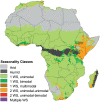Balancing water resources development and environmental sustainability in Africa: a review of recent research findings and applications
- PMID: 23238866
- PMCID: PMC3698319
- DOI: 10.1007/s13280-012-0359-1
Balancing water resources development and environmental sustainability in Africa: a review of recent research findings and applications
Abstract
Sustainable development in Africa is dependent on increasing use of the continent's water resources without significantly degrading ecosystem services that are also fundamental to human wellbeing. This is particularly challenging in Africa because of high spatial and temporal variability in the availability of water resources and limited amounts of total water availability across expansive semi-arid portions of the continent. The challenge is compounded by ambitious targets for increased water use and a rush of international funding to finance development activities. Balancing development with environmental sustainability requires (i) understanding the boundary conditions imposed by the continent's climate and hydrology today and into the future, (ii) estimating the magnitude and spatial distribution of water use needed to meet development goals, and (iii) understanding the environmental water requirements of affected ecosystems, their current status and potential consequences of increased water use. This article reviews recent advancements in each of these topics and highlights innovative approaches and tools available to support sustainable development. While much remains to be learned, scientific understanding and technology should not be viewed as impediments to sustainable development on the continent.
Figures






References
-
- Abell R, Thieme ML, Revenga C, Bryer M, Kottelat M, Bogutskaya N, Coad B, Mandrak N, et al. Freshwater ecoregions of the world: A new map of biogeographic units for freshwater biodiversity conservation. BioScience. 2008;58:403–414. doi: 10.1641/B580507. - DOI
-
- ADB (African Development Bank). 2008. Proposals for a clean energy investment framework—role of the African Development Bank Group. Tunis.
-
- Ambrosino C, Chandler RE, Todd MC. Southern African monthly rainfall variability: An analysis based on generalized linear models. Journal of Climate. 2011;24:4600–4617. doi: 10.1175/2010JCLI3924.1. - DOI
-
- Arthington AH, Naiman RJ, McClain ME, Nilsson C. Preserving the biodiversity and ecological services of rivers: New challenges and research opportunities. Freshwater Biology. 2010;55:1–16. doi: 10.1111/j.1365-2427.2009.02340.x. - DOI
-
- Bartlam-Brooks HLA, Bonyongo MC, Harris S. Will reconnecting ecosystems allow long-distance mammal migrations to resume? A case study of a zebra Equus burchelli migration in Botswana. Oryx. 2011;45:210–216. doi: 10.1017/S0030605310000414. - DOI
Publication types
MeSH terms
LinkOut - more resources
Full Text Sources

